-
The experience design page at Arup has a small blurb about the Hopkins Center project with a conceptual illustration. It is difficult to tell what space the image depicts, but it could be a new room built within the Hop Courtyard.
-
This has not been mentioned much, but the architect of record for the Snøhetta Hop project is EYP (see “Snøhetta to redesign Dartmouth College’s arts center,” The Construction Specifier (15 February 2021)). EYP is doing a lot in Hanover these days, including some of the Dartmouth Row remodelings. The firm also conducted studies that are leading up to the new power plant/green energy project.
-
See Katie Angen, “Dartmouth’s 1960s-era Anonymous Hall makes a name for itself with 2030 overhaul,” The Architect’s Newspaper (31 March 2021); David Malone, “Dartmouth College’s new faculty and graduate student center completes,” Building Design + Construction (26 February 2021); Matthew Marani, “With an Array of Sustainability Measures, Dartmouth’s Newest Building Stands Above the Pack,” Metropolis (2 June 2021). Some articles about Anonymous Hall refer to the space to the north as “a north quad,” which is fine, but others refer to “North Quad,” which does not seem right.
-
The current images for the Dartmouth Hall remodeling show the subtle front podium. At the moment, the project update page has an excellent photo of a shutterless building with scaffolding around the cupola. The renovation of the Charles Rich-designed building involves the insertion of new structural steel framing and concrete floors (Amar Scherzer, “Thornton Hall renovation to finish in summer, Irving Institute construction to complete in fall,” The Dartmouth (11 May 2021)).
-
A nice flythrough video shows the CECS building; for some reason the markings on the glass bridge that will indicate where the extra ten-foot segment was added do not appear in the video. Oh well. Instead of “Kemeny Hardenberg,” as shown on the HGA page, the entrance to the building in the video now reads “Center for Engineering and Computer Science.” How is the abbreviation pronounced, by the way — is it Kex or Secs? The North to West Utility Extension page shows how very large the building is.
-
There are several new photos of the Irving under construction and a new flythrough video available on the building’s project page. It is so good to see the facade of the old Murdough Center, its glass hoarding now white-framed instead of black, preserved within the new atrium.
-
Old news: the college constructed a pair of 60 x 120 skating rinks on the Green in January, and a light installation was installed in the Bema in February.
-
A fascinating study of early 19th-century parasitic infection has emerged from the summer 2019 archaeological work at the Choate House site on Wentworth Street (Amy Olson, “Studying 200-Year-Old Privy on Campus Hits Pay Dirt,” Dartmouth News (3 May 2021)). The recent growth in campus archaeology continues to thrill (and to revive a sense of regret over potential missed opportunities in the 1990s, including on the southeast corner of the Green).
-
Something’s going on around here: The privy article refers to “Dartmouth Libraries’ Baker-Berry Library” and the recent iconography article refers to “Dartmouth Library’s Baker Library.” Surely a reader of the official Dartmouth News website is not going to mistake Baker for a constituent facility of the Town of Hanover’s Howe Library? On a somewhat-related note, the new Indoor Practice Facility displays the words DARTMOUTH INDOOR PRACTICE FACILITY. Why the “DARTMOUTH”? Could it be mistaken for a Hanover High facility? Perhaps the word is just standing in for the name of a donor.
-
Influential planning historian John Reps died on November 12 (Edith Fikes and Patti Witten, “Urban planning historian John W. Reps dies at age 98,” Cornell Chronicle (25 November 2020)). He became interested in maps at Dartmouth, where he was a member of the Class of 1943. His history of his collecting is worth a read.
-
The book Beneath the Green: The Map at Dartmouth is a 2019 collection of student projects from Mary Flanagan’s mapmaking class.
-
See Merideth Barnett, “Honoring the Past, Shifting for the Future,” Currents Magazine (1 May 2021) for a look at campus traditions that includes Dartmouth among its examples. In this article, “advancement professionals and higher education researchers share why traditions endure, how they shift, and what role advancement today plays in celebrating and shaping them.”
-
Here is an interesting college tradition: digging up a different buried bottle of seeds every 20 years (Cara Giaimo, “One of the World’s Oldest Science Experiments Comes Up From the Dirt,” New York Times (21 April 2021).
Category Archives: Green, the
The fine line between clever and stupid
- A new site plan for the new dorm by the gym shows some refinement. The “bridge” element facing Crosby Street looks like the main entrance and responds to what planning analyses have identified as a major pedestrian route — the parking lot of the Heat Plant and Vox Lane. That’s nice, and one hopes the emphasis on this route helps cement the place of McKenzie and the Store House. But a good percentage of visitors to the new dorm will be arriving at the front of the building, at the Wheelock Street corner. No path is shown there. The construction timeline states “Commence Completion of Design phase – dependent on fundraising.”
- Dana Biomedical Library, reconstructed as Dana Hall, has been renamed Anonymous Hall (Dartmouth News, Valley News). Unlike, say, Nameless Field at U.Va., the building does not lack a namesake; its namesake is simply undisclosed. What would be an unfunny move if committed by the administration might be saved by the fact that it was requested by the donor of the renovation. The Guiarini School (formerly the School of Graduate and Advanced Studies) is headquartered in Anonymous Hall. The building contains a DDS cafe called Ramekin Cafe.
- More Irving renderings are available and a time-lapse video of construction is on line.
- Dartmouth Ruzicka is being rolled out on the school’s websites, a December article explains.
- Berry Mall has been torn up as part of the project to extend utilities to the west end of campus.
- The maples on the south end of the Green are coming down. They did always seem a bit diminutive for the space; too round in comparison to the elms, or something.
- An article in The Dartmouth explains the Fifty.
- A well drilled on the Green is being tested for use in a geoexchange system like the one in use at Fahey-McLane.
- A Valley News article on the projected library storage building.
- Lawrence Biemiller has a bit on the Hood in a post on lessons that campus buildings have taught.
- The college is in a partnership with a developer to build hundreds of apartment units for graduate and professional students near the hospital (Union Leader, Dartmouth News). It is hard to imagine how this could be anything but sprawl, but we will see.
- BGA Daily has photos of the indoor practice facility. It looks like the renderings! One does hope that the building will connect to the brick gateway of Scully Fahey Field, although it looks doubtful. There is a curious kind of preservation going on with the brick pier of the Boss Tennis Center: BGA Daily photo.
- An article on the new painting at the Skiway.
- Rauner Library has an exhibit on slavery at Dartmouth.
- The Reed Hall renovation designed by EYP is beginning (Dartmouth News).
- Some U.Va. students are saving the old card catalog that was being removed from the main library building (Washington Post), and the U.Va. administration is starting a campaign of plaques, markers, and tours focused on the history of the institution.
- If you enjoy Kate Wagner’s McMansion Hell, you’ll enjoy her “Duncing about Architecture” in the New Republic, about a proposed executive order titled “Making Federal Buildings Beautiful Again.” The group behind the proposed order, National Civic Art Society, counts the founder of Joe’s Dartblog among the members of its board of directors.
———-
Update 02.09.2020: NCAS item added.
New building projects and other topics
- The Valley News has an article on the 50th anniversary of the Parkhurst takeover.
- The DOC House at the head of Occom Pond is going to be renovated when there are enough donations.
- The Library is working with Russell Scott Steedle & Capone Architects, Inc., to design a new off-site storage facility:
Dartmouth plans to build a 20,000 sq ft stand-alone, purpose-built storage facility to house the library’s low-use print collections and College records. This facility, to be located on Dartmouth’s 56 Etna Road property in Lebanon, will replace the existing Library offsite storage facility[,] which is full. - An article in The Dartmouth details progress on the Indoor Practice Facility (this is the controversial project in the Sunken Garden) and Campus Services has information on the progress of the Boathouse addition.
- The year the bookstore died: Earlier this year, both the Dartmouth Bookstore (ca. 1872) and Wheelock Books (1993) closed up.
- Now that the Dartmouth Bookstore is gone, the Gitsis Building is being heavily renovated, the Dartmouth reports:
The building’s owner, Jay Campion, said that the renovations are already well underway and should be complete by July, which will allow the three tenants to start setting up their shops. According to Campion, the renovation process has involved a complete makeover.“We’ll be rebuilding the entire storefront and have basically gutted the building,” Campion said. “We’re re-insulating and replacing the heating and air conditioning systems for this and dividing the space for the three separate tenants on the first floor.”
- This public domain collection of images from the National Archives has an interesting group of photos of campus during WWI. Most of them show the trenches that were dug behind the gym, presumably where Leverone stands today. This photo shows a group of cars and trucks parked inside the southeast (or possibly northwest) corner of the gymnasium itself.
- Another new project: Renovations of the bluestone plaza in front of the Hopkins Center. The paving stones will be replaced with concrete pavers.
- Wilson Architects have posted an updated flythrough of the Thayer/CS Building. Now it is clear that the retaining wall to the west is actually the entrance to the garage; in this rendering, it is just vegetated rather than topped by a parapet and walkway.
- Not sure whether the new Planning, Design and Construction website has been mentioned here.
- In this Street View the Google employee with his camera backpack is reflected in the windows of Berry Library — as he walks through campus tour group.
- This post at Granite Geek solves the mystery of whether the NHDHR database called EMMIT is a reference to the derogatory student term “Emmit,” meaning a local person (or really, a New Hampshireman, not so much a townie). The answer is no.
- Lawrence Biemiller has a piece in the Chronicle of Higher Ed called “Make Way for Trenches! A College Plans to Scrap Its Entire Heating System.” It has good information on the upcoming heat plant and steam-to-water transition projects.
- When the new biomass plant is completed, the college will decommission the old heating plant behind New Hampshire Hall. Then it will have an empty building, historic and full of character and eminently reusable, right in the middle of the Arts District. The current feeling seems to be that the building will be demolished, along with its landmark smokestack. Here’s hoping that either or both can be saved, and if they are to be destroyed, at least they can be thoroughly documented first. The University of Virginia is doing the right thing by scanning University Hall, a 1965 domed concrete basketball arena.
- The Anthropology Department is leading n archeological aexcavation of an 18th-century house site on campus. That’s fantastic. It’s a pity that no one was doing this in the 1930s (or even the late 1980s, before the construction of the steam tunnel disturbed the east side of the Green).
- Unrelated: A week and a half ago, Union Pacific 4014, a 1940s steam locomotive with a 4-8-8-4 wheel arrangement, was brought back to life. Having seen a couple of Big Boys in impossibly derelict condition in Colorado and Wyoming in my youth, I never thought one of these locomotives would run again. Here’s a film of the colossus, double-headed with UP 844 (a 4-8-4): Film by Jaw Tooth. Here’s another clip by airrailimages. Astonishing.
Special flags number
The college flag, which is flown from the flagpole on the Green (see this July 2017 Street View image), has for decades been a simple Lone Pine in white upon a green field. The Co-Op still sells a version of it.
Last year, the Original Champions of Design created a new overall visual identity for Dartmouth that included a relatively subtle update of the Lone Pine. Instead of substituting the new pine for the old on the flag, however, the college has created a new flag featuring the “D-Pine” logo that OCD also created. The new flag is now flying on the Green and is visible in the photo published with this article in The Dartmouth of February 13 (thanks for the tip, Jon). OCD did a mockup of such a flag (it appears around page 11 of their site for this project) but the college appears to have taken the suggestion literally.
One needn’t dislike the D-Pine logo to question its appropriateness on a flag: the official college banner just seems a bit less purely symbolic and a bit more commercial now. The new logo definitely says “I am a logo,” and as a result the new flag speaks more to a brand, a glossy trademarked identity, than did the old flag. There is also a hint of the athletic about it — again, appropriate for many situations, but not necessarily right for the college flag.
This flag was spotted at an Interstate rest area:
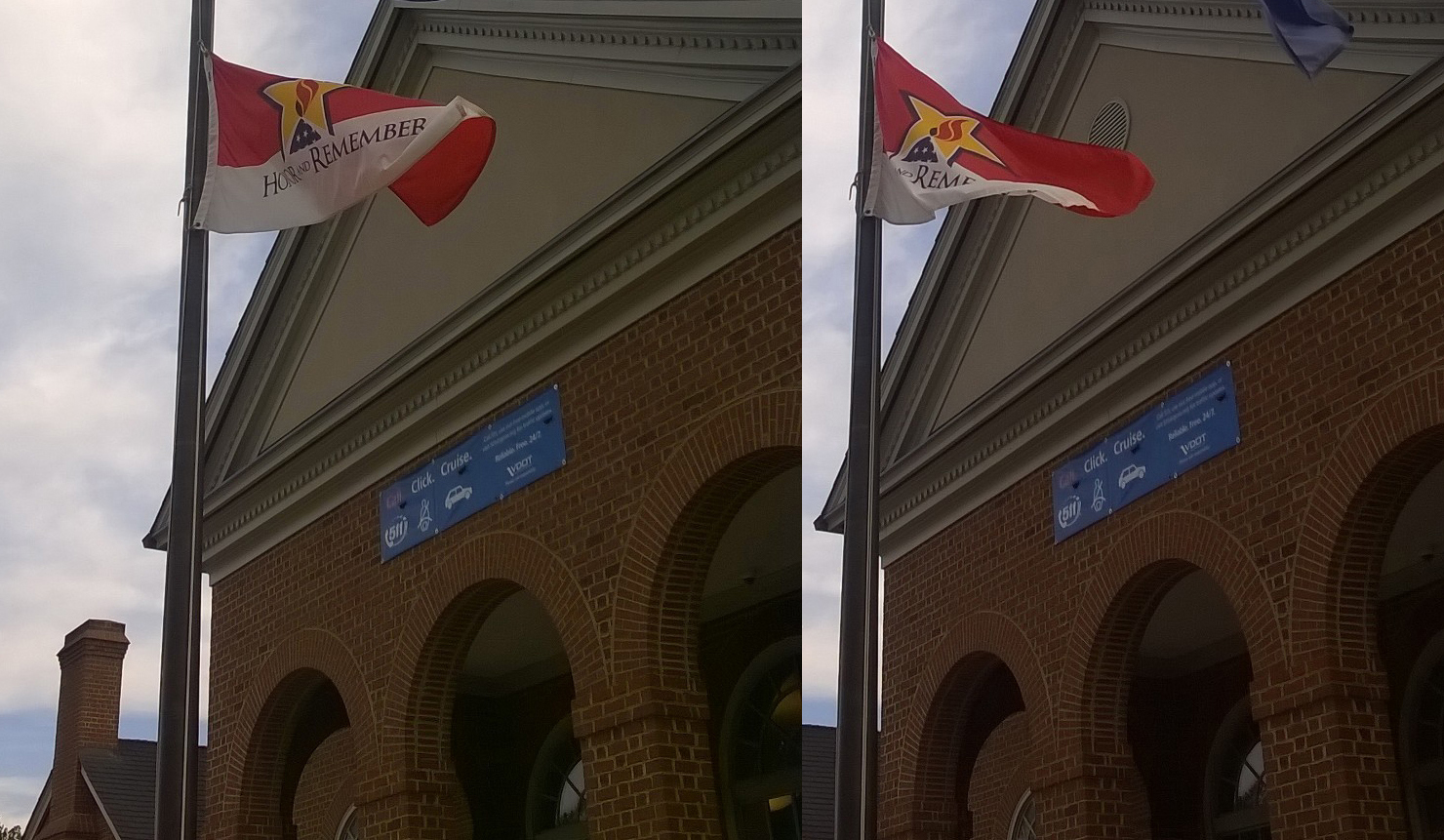
(Wikipedia).
The phrase “the Thin Red Line” calls to mind the Battle of Balaclava (to a dedicated 1980s MilMod reader, at least). Lately it’s been applied to firefighters, following the pattern of “the Thin Blue Line” of the police. With this flag, spotted at a Highland Games, you get two for the price of one, and there’s no scrimping on the width of the line either:
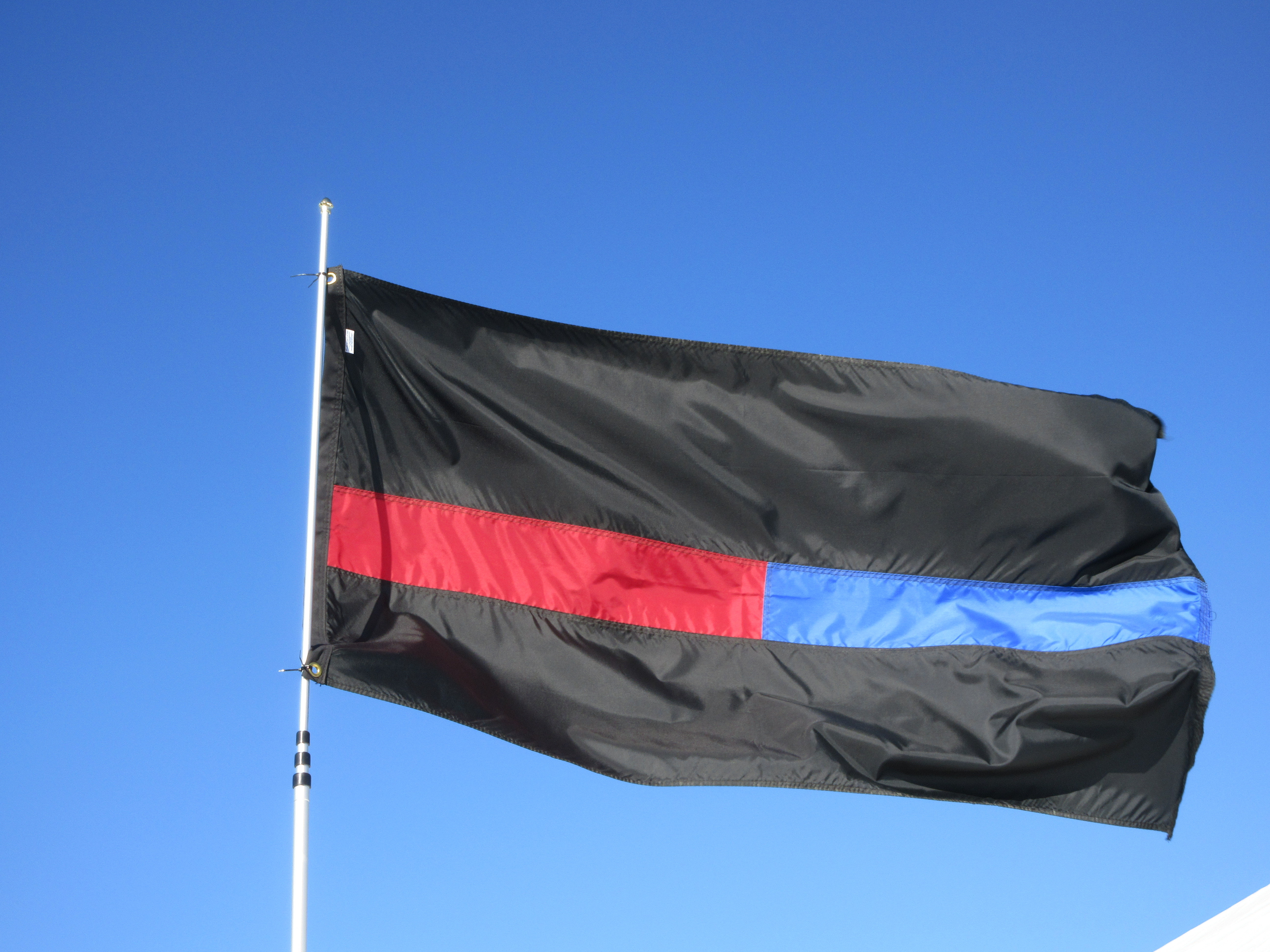
At the same event, this Celtic collage (FOTW):
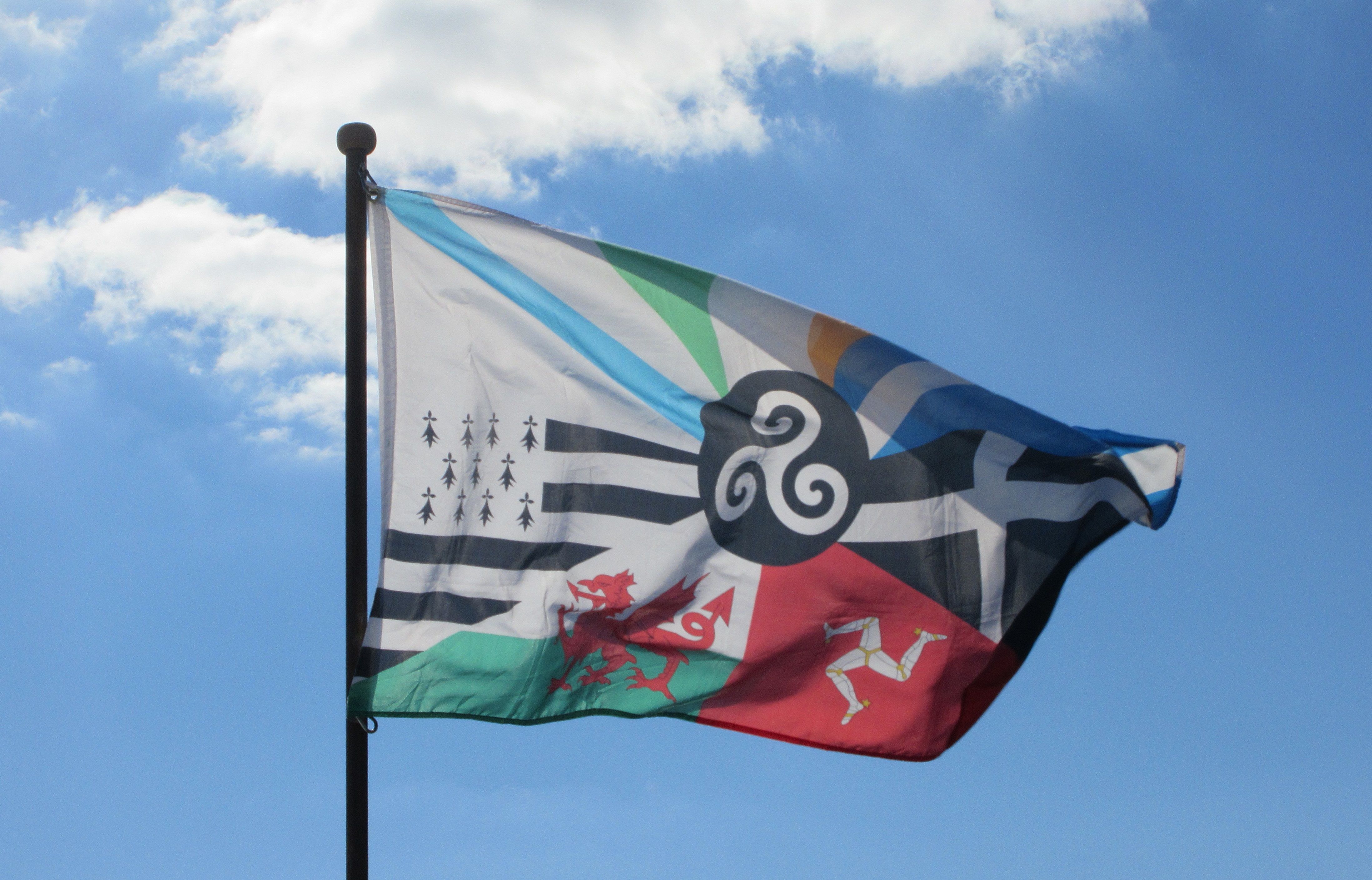
There are beer taps affixed to this depiction of the flag of Virginia, which itself displays the obverse of the great seal of the Commonwealth of Virginia:
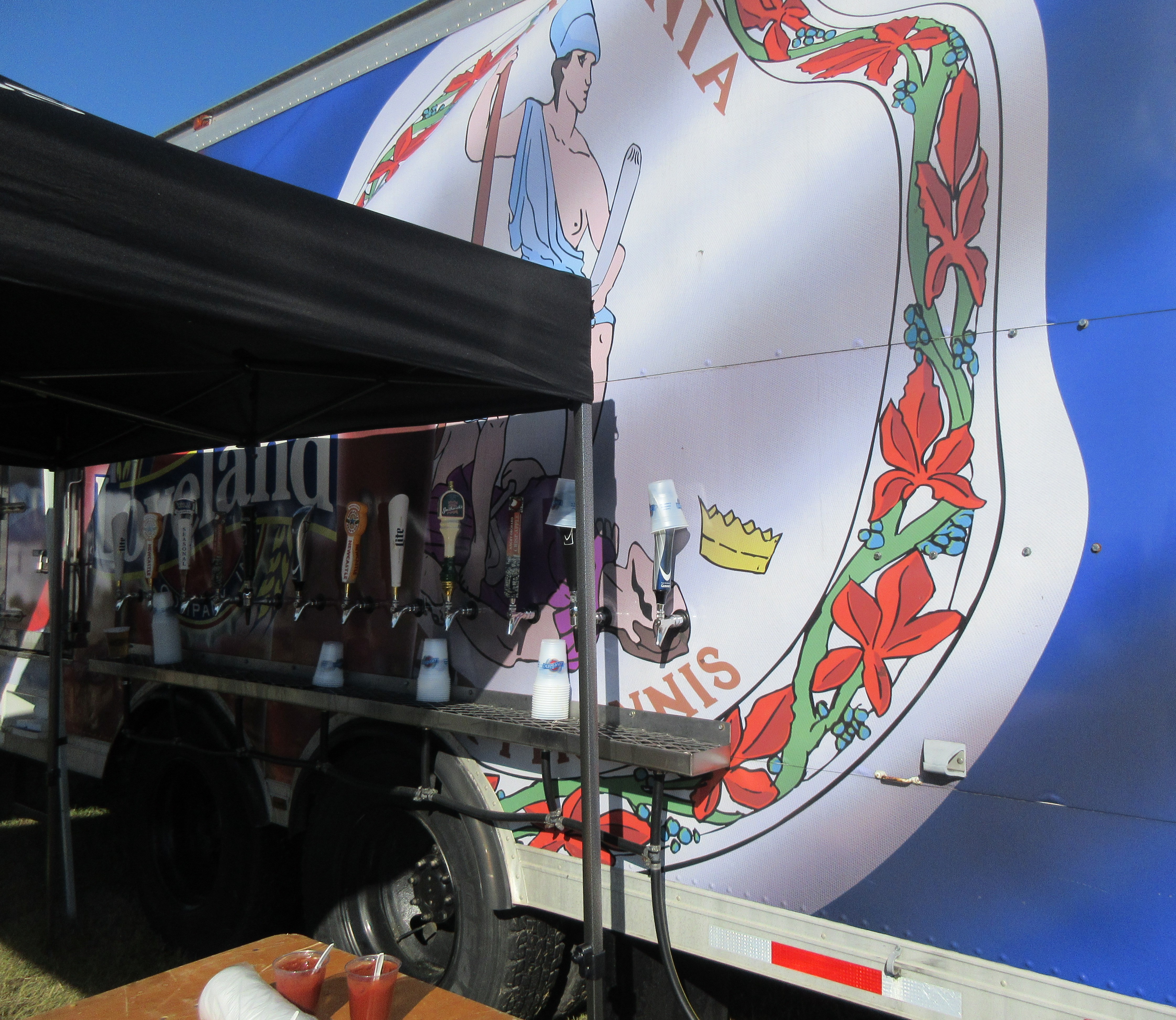
Finally, here is an odd collection, including (l-r) the Virginia flag, a Pride version of the U.S. flag, the big flag of the River City Red Army, the flag of the City of Richmond, an ice cream flag, and an Australian flag defaced by a boxing kangaroo.
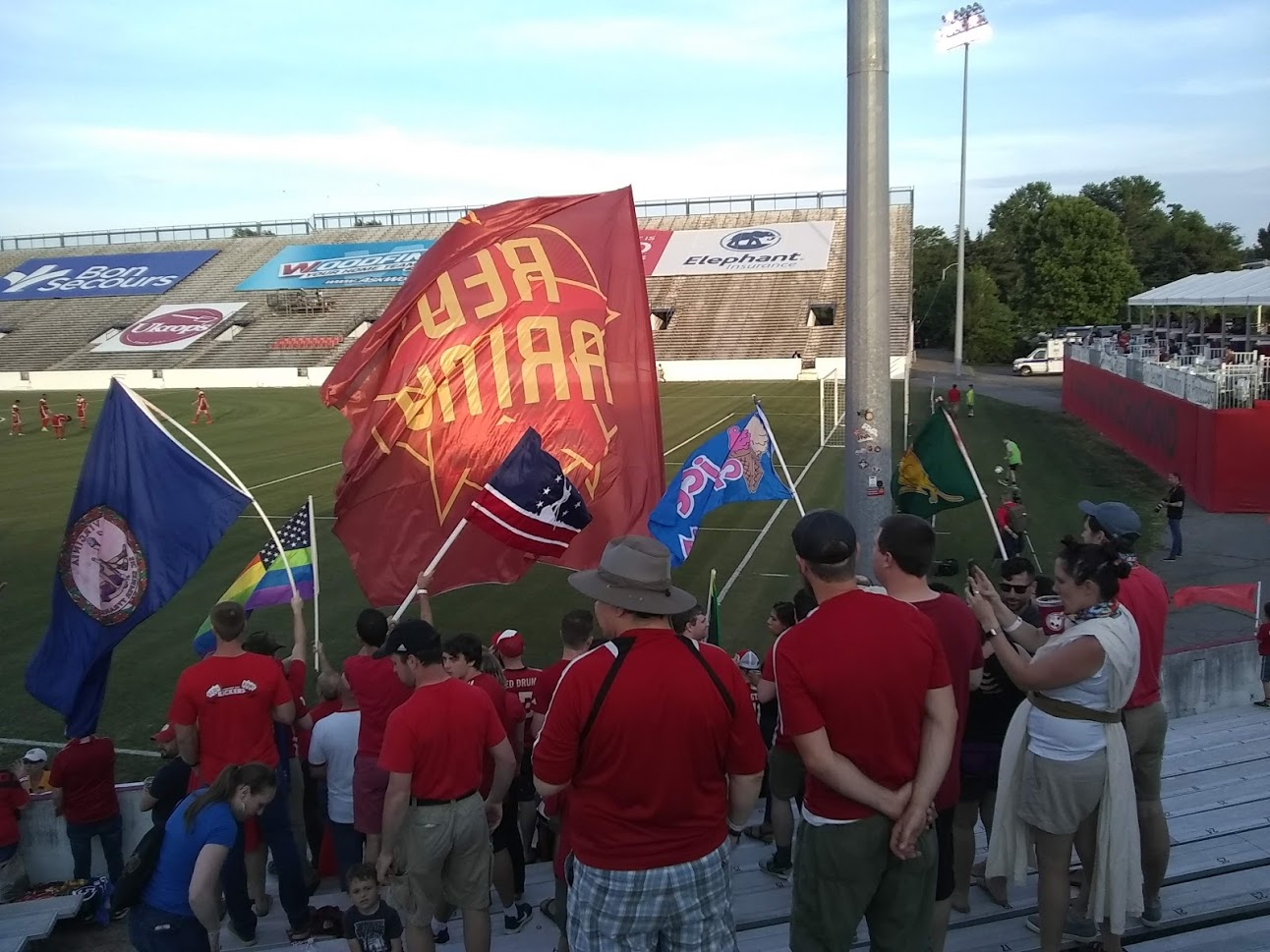
A statue of Fred Harris? And other tidbits
-
Sasaki Associates now has a page for its House Centers “pilot” program. This SCUP article has a “housing swarm” image that Sasaki created for Dartmouth. A Valley News article states that the college “estimated it will cost $12.8 million to build professors’ residences and temporary centers for Dartmouth’s Undergraduate House Communities program.” But those have already been built. Presumably that estimate refers to completed construction. Any future, permanent versions of those buildings will cost a lot more than $13 million.
-
BBB has updated its page on the campus master plan to include a large version of that plan, an image of the West End plan (Green to Blue), and — this is new — a schematic perspective rendering of the cemetery bridge, which we can call Fletcher Viaduct.
-
This Valley News article notes Kendal’s interest in building to the south on Rivercrest land and leaving the Chieftain land for recreation (rowing).
-
Sir John Soane’s Museum in London has a computer model of the museum on line.
-
The architects have completed a design for the Irving Institute (Valley News).
-
The Dartmouth has an article on the success of the Town fence in front of Collis in reducing jaywalking.
-
The Hood has a brochure on public art on campus. The Class of 1965 has proposed to erect a statue of DOC founder Fred Harris in front of Robinson Hall. The campus architecture committee is considering the idea, according to the ’65 newsletter.
-
A bit of biography on David Hooke, who’s at the center of the new Moosilauke Ravine Lodge.
-
Dartmouth will play Brown at football in Fenway Park on November 10, Big Green Alert reports. Wild.
-
The Rauner Library Blog has a post about the Charter.
-
Kresge Library in Fairchild has turned 40 years old.
-
This Times editorial contains footnotes. Kinda neat, but also showy: if footnotes are needed here, why not everywhere? Or if the paper is to be relied on generally, why include notes here?
-
Big Green Alert points out the new use of the Lone Pine logo by the Co-Op. First impression? The trad typeface clashes with the fat Modernism of the pine. The use of the athletics nickname BIG GREEN in this seal-like, college-wide institutional device is also weird.
-
A Proliferation of Canes. Photos of the most recent Commencement show students carrying many strange, new-ish canes, most presumably representing senior societies. They feature a snake wrapped around a Native American arrow; a bearded old man; the domed main body of Shattuck Observatory (clever!); a snake clutching an apple in its mouth; a huge phoenix (for Phoenix, obviously — is that cast resin or something?); a tail, perhaps belonging to a whale?; and a three-dimensional stylization of the stylized Lone Pine symbol (also a metal globe).
-
Two interesting new-ish concepts: literary geography and forensic architecture.
Some campus photos and notes

The first stage of the steam tunnel’s construction, south of this grate, was a test meant to determine whether such a project would be economical in a ledge environment.
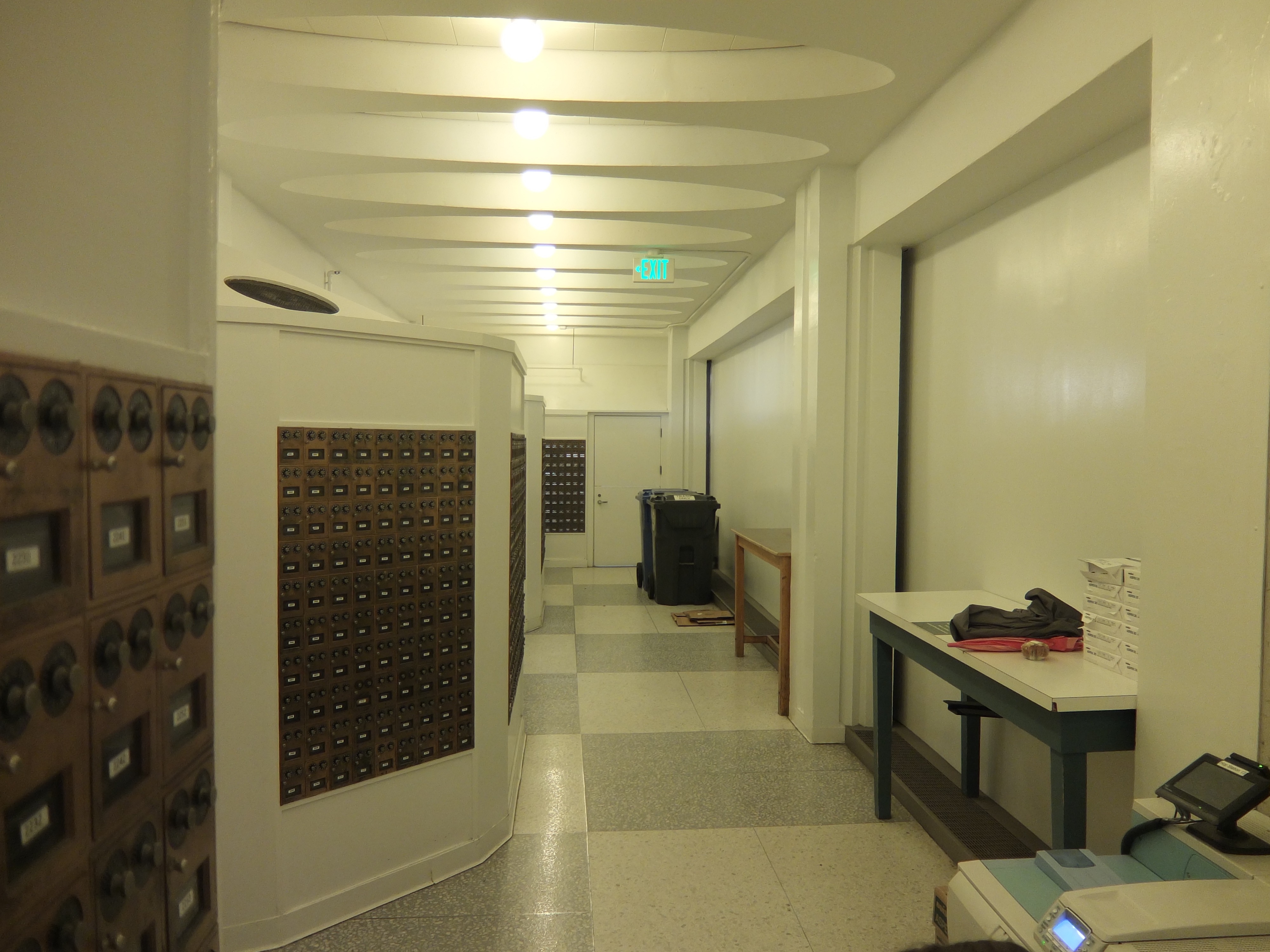
Until recently, students entered the Hop at the end of the room. The entrance was closed off and a replacement of the same configuration built just to the north.
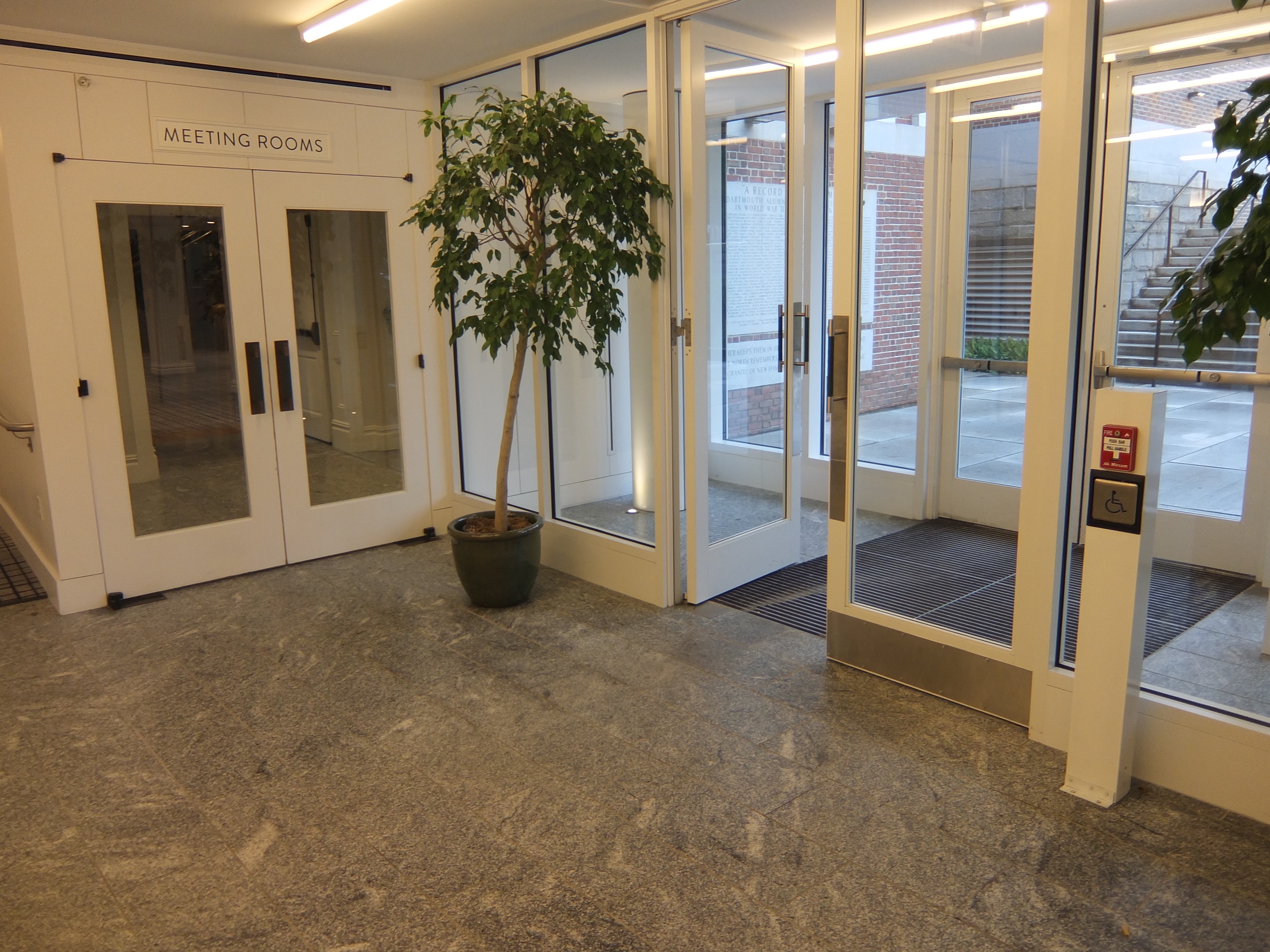
(Have the memorial plaques attached to the Inn there been moved to Memorial Field? That would make sense. This is not their first location anyway.)
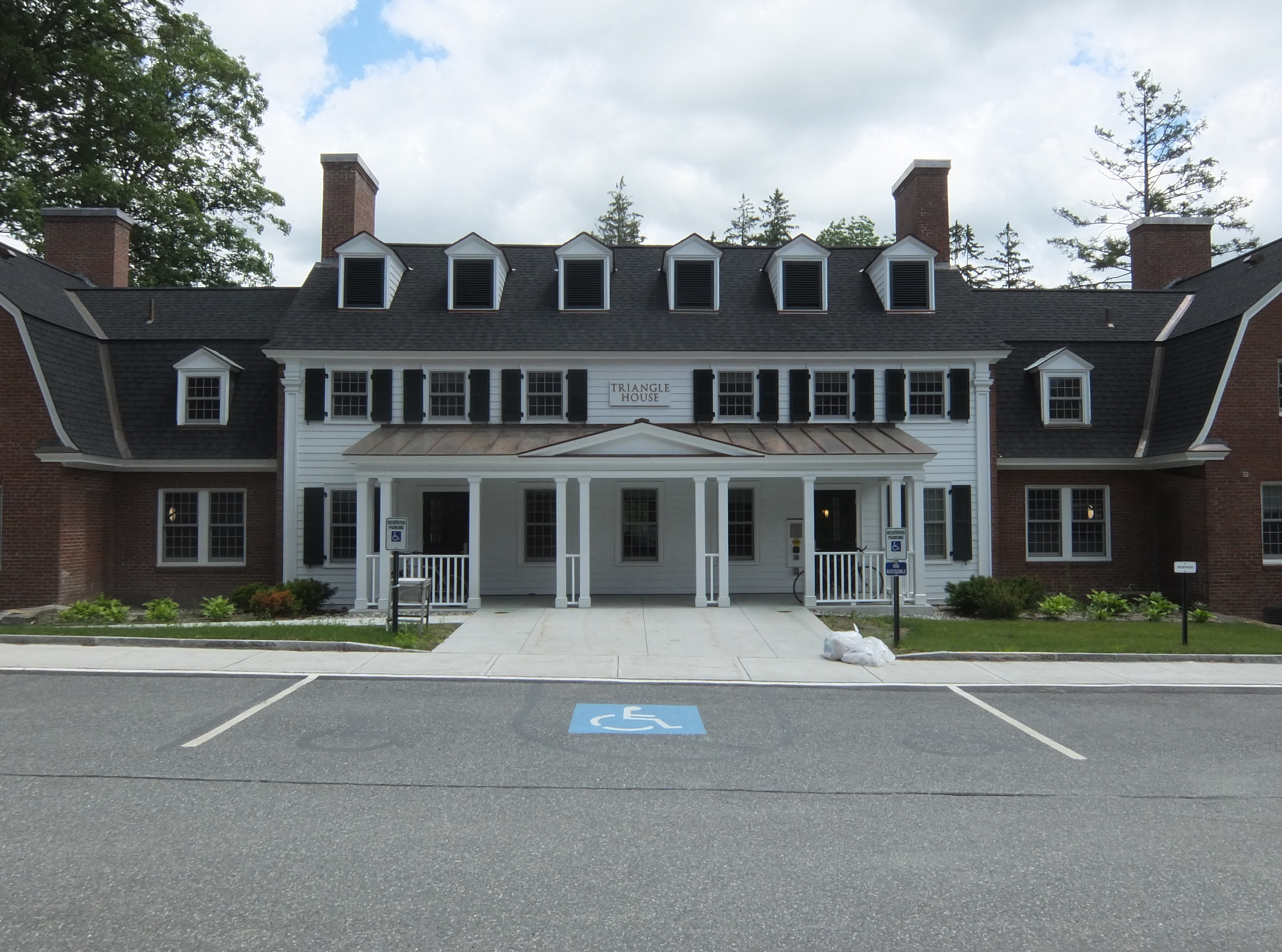
Even more than the society houses on the south side of Webster Avenue, Triangle House has a well-used student entrance on one side, shown here, and a formal street entrance on the other.
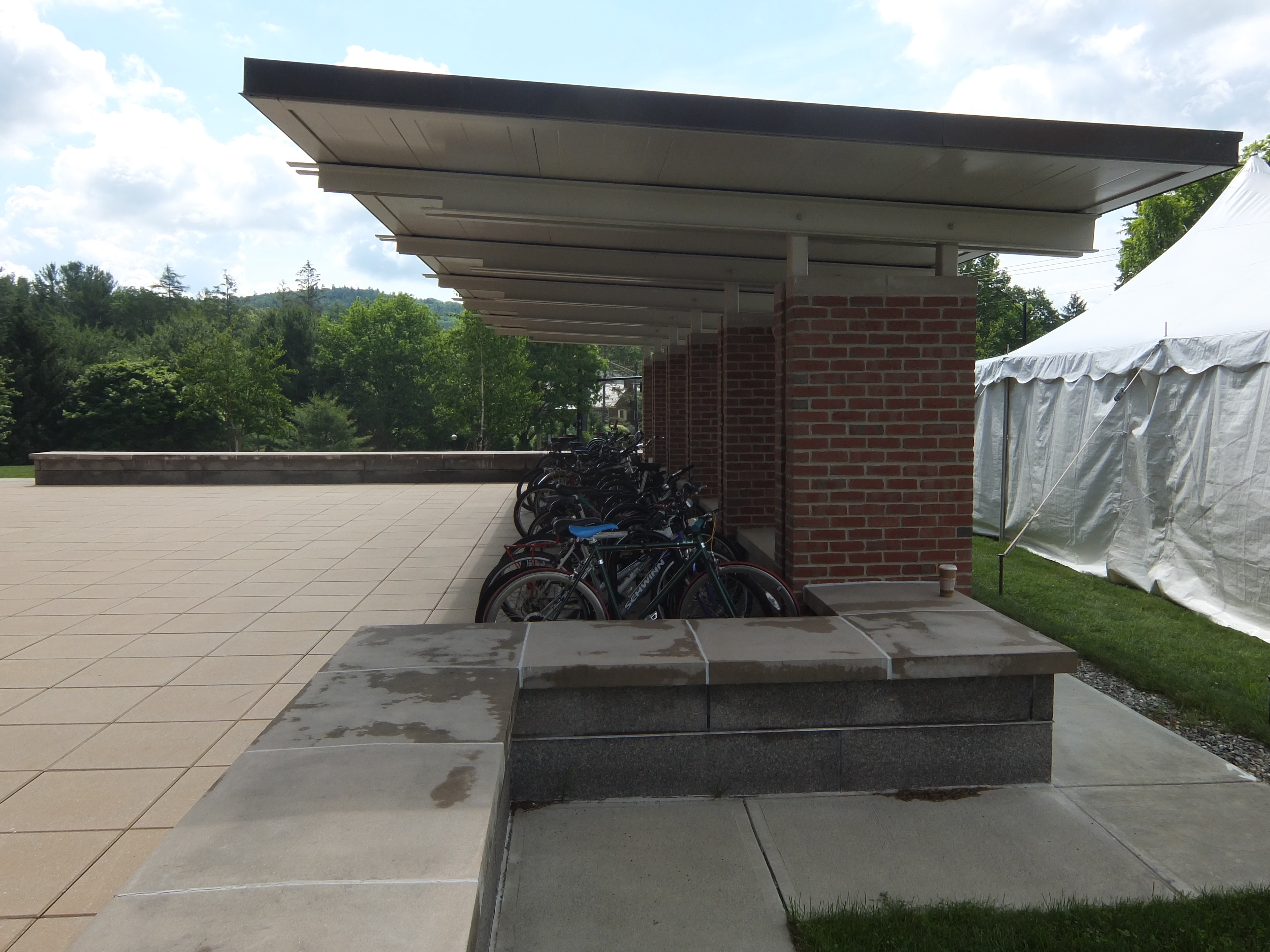
This elaborate bicycle shelter for the Life Sciences Center joins a couple other pavilions in the area.
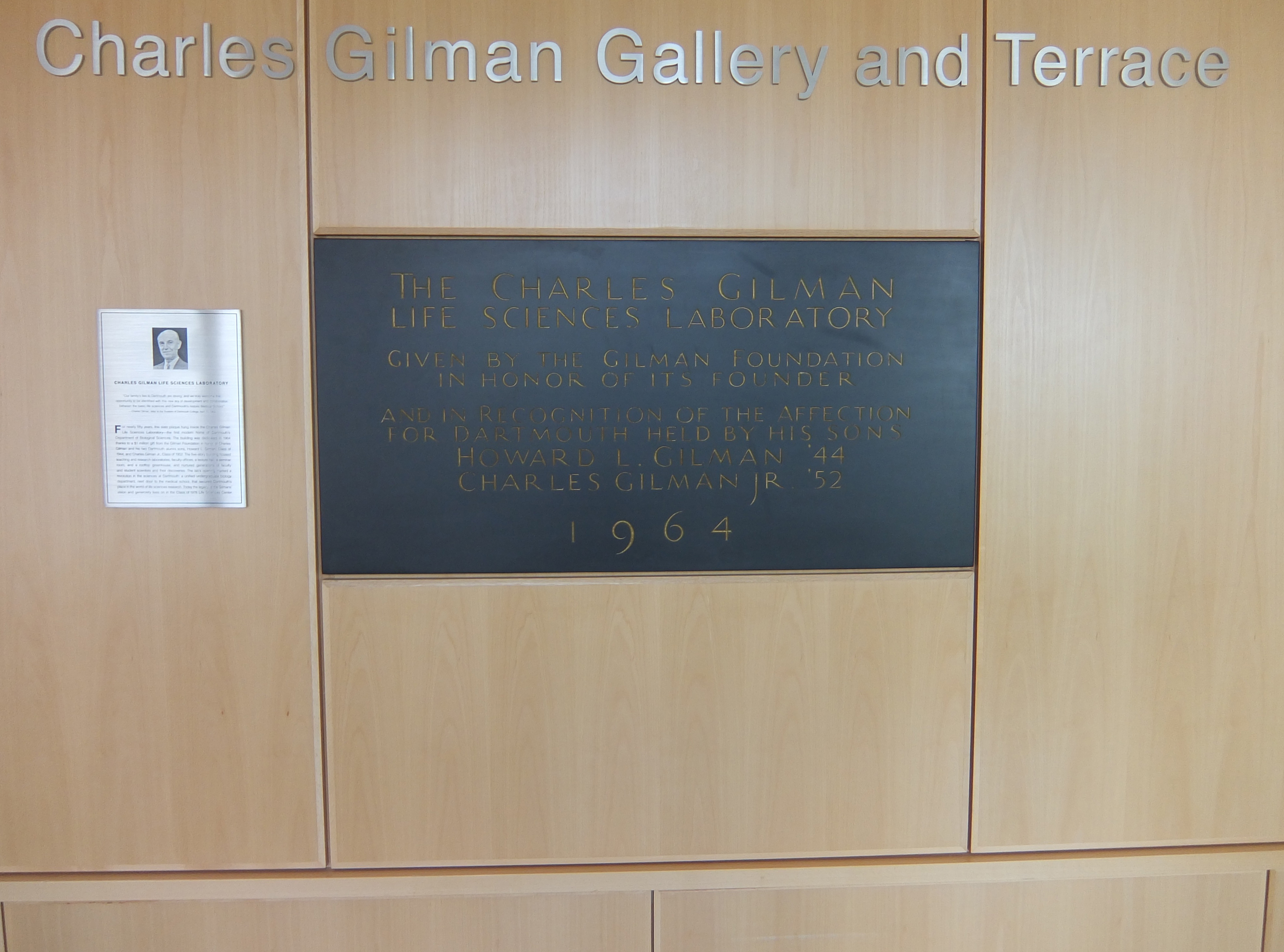
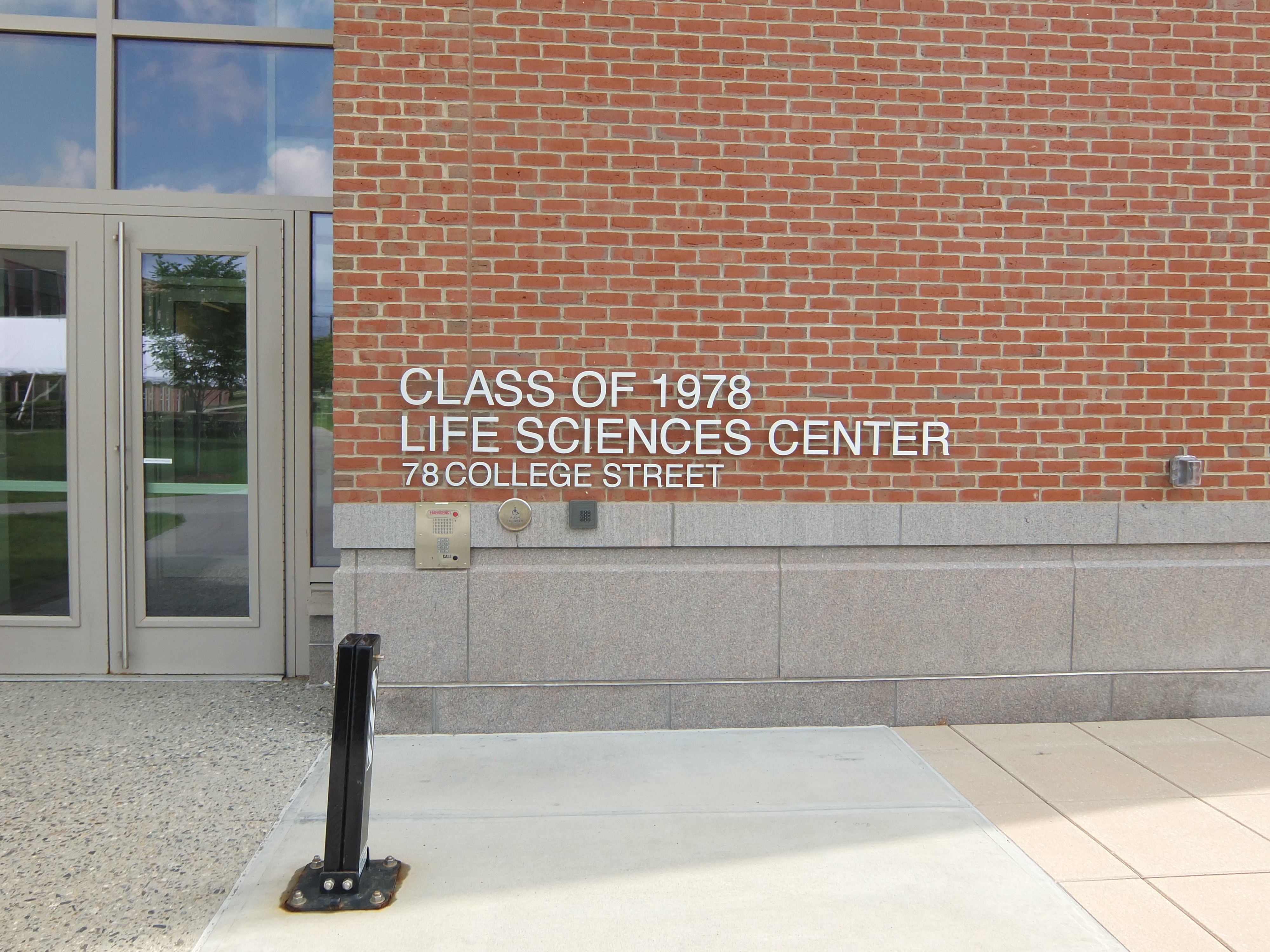
The town changed the street address of the building to get it to match.
Investiture and other topics
-
The report of the 210th Alumni Council meeting updates us on plans underway to create a freestanding School of Graduate Studies that will coordinate the 17 Ph.D. programs and 12 Masters’ programs that exist alongside the professional degrees of the three professional schools. Grad Studies is now holding its first investiture ceremony (Dartmouth Now). The coat of arms was just the first step…
-
The Council meeting summary states that “[t]he College has also received sufficient donations to support the initial year of the new residential model of house communities.” That’s an interesting funding method; presumably in the long term the school will seek a naming gift for each Community. The funding element is not mentioned in the full report, although the need for heraldry (again) is foreshadowed:
House programming budgets will support a wide range of activities including “feeds,” intramurals, concerts, field trips, new annual traditions, alumni events, house swag, experiential learning, and leadership development activities.
Happy to see the term “feed” surviving.
-
It was a surprise to find last year that the famous Concord Coach that regularly carried the football team to the railroad station more than a century ago still existed (post). Now, courtesy of Time Well Kept: Selections from the Wells Fargo Corporate Archives, we learn that the coach of famous Hanover liveryman Ira Allen survives as well! From the book:
J.S. and E.A. Abbot and Company built coach #746 in the spring of 1864 for New Hampshire stage operator Ira B. Allen, who ordered his coach made two inches narrower and lighter than other typical nine-passenger coaches. Coach builders painted #746 dark green, a standard but seldom-chosen color requested by Allen, whose staging business in Hanover carried many students and visitors to Dartmouth College.
The coach, which is no longer painted green, is on display in Miami.
-
The Alumni Magazine in its May-June issue featured a number of historic photos of life at the college, carefully colored by Sanna Dullaway. The photo of the Golden Corner and watering trough, the tenth or so image, looks like it gets the color right.
-
The Big Green Alert continues to cover progress at Memorial Field, with photos on May 14, 20, and 22, and June 4.
-
Really intriguing things are going on with the proposal for a natural gas pipeline from Lebanon to the Heating Plant via DHMC (Valley News).
-
Received the latest campus map through email ahead of the reunion next weekend. It looks nice. It labels all of the sports fields and, possibly for the first time, labels the Softball Park and Burnham Pavilion (I thought that one was also unnamed as the Sports Pavilion?). It depicts the Lewiston buildings. It calls attention to the fact that the parking lot behind Thayer/53 Commons is still called “DDA Lot,” even though DDA became DDS a quarter-century ago. One does wish that the mapmakers would abbreviate the “Saint” in the names of the churches. And is the official name of the cemetery really the “Town of Hanover Cemetery,” when it was built on college-owned land and run by the Dartmouth Cemetery Association? Finally, one hopes that the roadway labeled “Old Tuck Drive” is not called that in practice. There is no “new” Tuck Drive to distinguish it from, and it’s the same as it ever was: Tuck Drive.
-
The Dartmouth reports on Tri-Delt’s decision to go local.
-
The website of Gamma Delta Chi documents the changes that the organization is making to its house, including an extensive set of alterations to the Pit.
-
The Valley News, reporting on the AD derecognition, quotes college spokeswoman Diana Lawrence:
“Students are free to join any organization that’s not recognized by the college,” she said, so as far as Dartmouth is concerned, “they can become Freemasons.”
In case you were wondering in 1799, “the Board of Trust declared itself in a decree that any student becoming a mason should thereby cease to be a member of College.”1John King Lord, A History of Dartmouth College, 1815-1909 (Concord, N.H.: The Rumford Press, 1913 ), 520.
-
The Rauner blog has an interesting post on the ownership of the Green.
-
The voters of the Town defeated the West Wheelock Gateway District proposal (Valley News).
—————
| ↑1 | John King Lord, A History of Dartmouth College, 1815-1909 (Concord, N.H.: The Rumford Press, 1913 ), 520. |
|---|
Photography at the 1904 visit of the Earl of Dartmouth
These two photos from the Archives show the arrival of the Earl of Dartmouth in 1904:
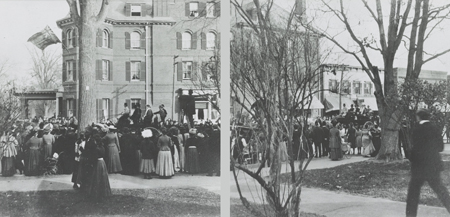
The photos were taken from the steps of Casque & Gauntlet looking east toward the Inn. The righthand photo is the earlier of the two, and the Earl’s carriage appears in both photos. The student with the white collar striding down the walkway in the righthand photo is also visible at the edge of the left photo.
In the left photo a professional photographer is visible, standing on a stepladder behind a large camera. He might have a cigar in his mouth.
What kind of image did he capture? Here is a photo he took a few seconds after the two photos above; the Earl’s carriage has already rounded the corner:
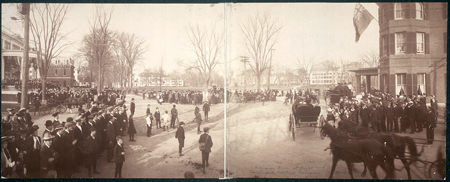
This photo is from the Library of Congress, which lists the copyright holder as E. Chickering & Co. A slightly cropped version of this photo is available in the Dartmouth Archives.
The ol’ Homecoming bonfire myth
Yes, students built a bonfire in 1888. They were celebrating a baseball victory over Manchester that April.1Dartmouth Baseball, “All-Time Game-by-Game Results,” available at http://goo.gl/NUsk7k (viewed 26 October 2014). The Dartmouth wrote that “[t]he convulsive joy of the underclassmen burst forth on the night of the first Manchester game in the form of a huge Campus fire. It disturbed the slumbers of a peaceful town, destroyed some property, made the boys feel like they were men and in fact did no one any good.”2Editor, The Dartmouth (4 May 1888), quoted in “Who designs and builds the homecoming bonfire? What’s the history behind it?,” Ask Dartmouth (updated 20 October 2011), at http://ask.dartmouth.edu/categories/stulife/24.html (viewed 26 October 2014).
For some reason, people keep saying that that was the bonfire that started it all.3See Rauner Library Blog (16 October 2011), at http://raunerlibrary.blogspot.com/2011_10_16_archive.html (viewed 26 October 2014); “Who designs and builds the homecoming bonfire? What’s the history behind it?,” Ask Dartmouth (updated 20 October 2011), at http://ask.dartmouth.edu/categories/stulife/24.html (viewed 26 October 2014). Bonfires were spontaneous things in the nineteenth century, and it is not clear why there has to be a “first” one. At any rate, that 1888 bonfire — lit after a springtime baseball victory — wasn’t the first bonfire built by students in Hanover by any means.
For example, as one alumnus recalled, the baseball victory over Williams of June4Dartmouth Baseball, “All-Time Game-by-Game Results.” of 1887, nearly a year before the Manchester game, involved a bonfire:
After supper the celebration is begun by songs on the campus fence, and as soon as it is really dark a bonfire is built in the campus, and every man’s unprotected woodpile is levied on for the purpose. Then a line is formed again and marches through the principal streets. A stop is made at the house of every member of the faculty, and he must make a speech and be cheered also. At length the bonfire burns low, and the cheering ceases, and it is the dead of night.5William Byron Forbush, quoted in Harold Seymour, Baseball: The People’s Game (New York: Oxford University Press, 1960), 145-146.
And before that:
- May of 1874: “Serenade your instructors occasionally, burn somebody’s chicken coop.”6”Editorial Department,” The Dartmouth 8:5 (May 1874), 187.
- During March of 1874, a student wrote of a grand bonfire on the campus fed with fence rails and dry-goods boxes and kindled with kerosene.7”The Spirit of ’76,” The Dartmouth 8:3 (March 1874), 98.
- Also ca. 1874: “‘Extra curriculum activities’ included occasional pranks like hanging somebody’s wagon in a tree, or getting a horse into chapel, or having a sort of spontaneous bonfire on the campus, for which loose material was swiped from back yards, — such as barrels, boxes, a stray ladder of, in extreme cases a part of a fence.”8Robert Fletcher, “Hanover Scenes in Word Pictures Sixty Years Ago” part 3, “Town Meetings and Travel,” The Hanover Gazette (March 22, 1934), 1.
- Ca. 1868-1872, students participated in “[t]he lawless collection of materials for a celebrating bonfire and heaping of all the gates in the middle of the Green.”9Edwin J. Bartlett, A Dartmouth Book of Remembrance: Pen and Camera Sketches of Hanover and the College before the Centennial and after (Hanover, N.H.: The Webster Press, 1922), 66-68. Bartlett also wrote of student-built fires blazing in “Mere Football,” Dartmouth Alumni Magazine 19, no. 1 (November 1926), 20.
- (Not to mention the bonfires built by townsfolk during February of 1819 when news of the College victory in the Supreme Court reached town.10Samuel Brown, “Historical Address,” Dartmouth Centennial Celebration (1870), 33. Rufus Choate also heard of the lighting of bonfires and “other unseemly demonstrations of joy” at the time. Rufus Choate to brother (25 March 1819), quoted in Clyde Edward Dankert, “Dartmouth College and Dartmouth University” typewritten MS (1979), 145, citing Dartmouth Alumni Magazine (February 1969), 24.)
After the non-milestone of the 1888 Manchester baseball bonfire, students would keep on building bonfires independently of Dartmouth Night for a good half-century. Sometimes they did not even need an intercollegiate athletic victory.
During September of 1888, a ten-boat regatta of the Dartmouth Boating Association traveled three miles upriver and built bonfires on the “second island.”11Robert Fletcher, “Hanover Scenes in Word Pictures Sixty Years Ago” part 5, The Hanover Gazette (April 5, 1934), 1. In November of 1893, students built “an honest bonfire”12The Dartmouth (ca. November 1893) (“It was an honest victory and appropriately celebrated with an honest bonfire.”), quoted in Will Meland, “Bonfire burns bright for more than century of change,” The Dartmouth (27 October 2000), available at http://goo.gl/Wd7nYi (viewed 1 November 2014). on the Green after the football team defeated Amherst. During the fall of 1896, the Dartmouth-only freshman-sophomore football game was followed by a bonfire.13Leonard Wason Tuttle, “Chronicles,” Book of the Class of 1900 (ca. 1900), 40. The Aegis wrote of this event: “The Freshmen have a small fire on the Campus, and cut up $200 worth of hose with the jack-knives their papas gave them when they left home.” Dartmouth Class of 1899, Aegis 1899 (1897), 173. In September of 1901, the Webster Centennial celebration saw a parade end on the Green, where a bonfire was lit.14”After a Century,” Boston Herald (25 September 1901), 3. There were fireworks afterward.
During November of 1903, the “stay-at-homes” listened to a reading of the telegraph reports of the football victory over Harvard at the first game in its new Stadium: “When the last message arrived, the students withdrew to collect material for a huge bonfire — and the work was not confined to the Freshman class!”15The Dartmouth (25 November 1903), in Edward Connery Lathem and David M. Shribman, eds., Miraculously Builded in Our Hearts: A Dartmouth Reader (Hanover, N.H.: Dartmouth College, distributed by University Press of New England, 1999), 28. After a meeting in Dartmouth Hall’s Old Chapel and a parade, “[t]he fire was lighted at 8:30 o’clock, and it was one of the biggest blazes in recent years. Around the fire the men sang songs and cheered wildly, and then indulged in a nightshirt parade, which ended one of the most memorable athletic celebrations in Dartmouth’s history.”16The Dartmouth (25 November 1903), in Lathem and Shribman, 29. During October of 1904, students built a bonfire on the Green and had a “nightshirt parade” around the fire.17Royal Parkinson to father (30 October 1904), in Lathem and Shribman, 43.
Skipping ahead to 1919, the springtime handover of student government from one Palaeopitus class to the next involved a bonfire in which Freshmen were allowed finally to dispose of their Freshman Beanies.18Clifford B. Orr to family (9 June 1919), in Lathem and Shribman, 99.
Wait a minute, what about Dartmouth Night? Yes, President Tucker established Dartmouth Night during the fall of 1895, but it was an indoor event, in the Old Chapel in Dartmouth Hall. A bonfire simply was not a part of the original event.19Cf. Rauner Library Blog (16 October 2011), at http://raunerlibrary.blogspot.com/2011_10_16_archive.html (viewed 26 October 2014). Between 1901 and 1906, the location of Dartmouth Night shifted between outdoor sites (the College Yard below Dartmouth Hall as well as Alumni Oval, the proto-Memorial Field) and indoor sites (Commons, a.k.a. Collis Commonground). Dartmouth Night would move to its long-term indoor site of Webster Hall in 1907.
It was apparently not until the 1920s, perhaps the late 1920s, that Dartmouth Night began to include a pre-game rally and bonfire. In 1930, for example, the ceremony seems to have evolved into a Friday evening torchlight parade to the President’s House for a short talk on spirit, followed by a bonfire on the Green.20Richard N. Campen letter (11 November 1930), in Lathem and Shribman, 136. At that 1930 bonfire, students sang (football) songs and gave (football) yells in honor of the last home game,21Campen in Lathem and Shribman, 136. which would occur the following day. In 1931, Dartmouth Night was celebrated with what were described as “all of the traditional accompaniments, including the bonfire on the campus.”22”News of the College,” Dartmouth Alumni Magazine (December 1931), 175.
Even attaching a pre-game bonfire to an outdoor Dartmouth Night did not reduce the annual number of fires to one. Students were still building multiple bonfires each year, including big ones for Dartmouth Night and Houseparties Weekend,23See, for example, Forrester Maphis and John S. Hatfield, eds., Aegis 1950 (1950), 56. into the mid- or late-1960s. Eventually, possibly after the campus turmoil of the Vietnam era had subsided, students would build only one bonfire each year, in the fall, on Dartmouth Night. Even later, that weekend — today still known officially as “Dartmouth Night Weekend” — would become popularly known as “Homecoming.”
——
| ↑1 | Dartmouth Baseball, “All-Time Game-by-Game Results,” available at http://goo.gl/NUsk7k (viewed 26 October 2014). |
|---|---|
| ↑2 | Editor, The Dartmouth (4 May 1888), quoted in “Who designs and builds the homecoming bonfire? What’s the history behind it?,” Ask Dartmouth (updated 20 October 2011), at http://ask.dartmouth.edu/categories/stulife/24.html (viewed 26 October 2014). |
| ↑3 | See Rauner Library Blog (16 October 2011), at http://raunerlibrary.blogspot.com/2011_10_16_archive.html (viewed 26 October 2014); “Who designs and builds the homecoming bonfire? What’s the history behind it?,” Ask Dartmouth (updated 20 October 2011), at http://ask.dartmouth.edu/categories/stulife/24.html (viewed 26 October 2014). |
| ↑4 | Dartmouth Baseball, “All-Time Game-by-Game Results.” |
| ↑5 | William Byron Forbush, quoted in Harold Seymour, Baseball: The People’s Game (New York: Oxford University Press, 1960), 145-146. |
| ↑6 | ”Editorial Department,” The Dartmouth 8:5 (May 1874), 187. |
| ↑7 | ”The Spirit of ’76,” The Dartmouth 8:3 (March 1874), 98. |
| ↑8 | Robert Fletcher, “Hanover Scenes in Word Pictures Sixty Years Ago” part 3, “Town Meetings and Travel,” The Hanover Gazette (March 22, 1934), 1. |
| ↑9 | Edwin J. Bartlett, A Dartmouth Book of Remembrance: Pen and Camera Sketches of Hanover and the College before the Centennial and after (Hanover, N.H.: The Webster Press, 1922), 66-68. Bartlett also wrote of student-built fires blazing in “Mere Football,” Dartmouth Alumni Magazine 19, no. 1 (November 1926), 20. |
| ↑10 | Samuel Brown, “Historical Address,” Dartmouth Centennial Celebration (1870), 33. Rufus Choate also heard of the lighting of bonfires and “other unseemly demonstrations of joy” at the time. Rufus Choate to brother (25 March 1819), quoted in Clyde Edward Dankert, “Dartmouth College and Dartmouth University” typewritten MS (1979), 145, citing Dartmouth Alumni Magazine (February 1969), 24. |
| ↑11 | Robert Fletcher, “Hanover Scenes in Word Pictures Sixty Years Ago” part 5, The Hanover Gazette (April 5, 1934), 1. |
| ↑12 | The Dartmouth (ca. November 1893) (“It was an honest victory and appropriately celebrated with an honest bonfire.”), quoted in Will Meland, “Bonfire burns bright for more than century of change,” The Dartmouth (27 October 2000), available at http://goo.gl/Wd7nYi (viewed 1 November 2014). |
| ↑13 | Leonard Wason Tuttle, “Chronicles,” Book of the Class of 1900 (ca. 1900), 40. The Aegis wrote of this event: “The Freshmen have a small fire on the Campus, and cut up $200 worth of hose with the jack-knives their papas gave them when they left home.” Dartmouth Class of 1899, Aegis 1899 (1897), 173. |
| ↑14 | ”After a Century,” Boston Herald (25 September 1901), 3. There were fireworks afterward. |
| ↑15 | The Dartmouth (25 November 1903), in Edward Connery Lathem and David M. Shribman, eds., Miraculously Builded in Our Hearts: A Dartmouth Reader (Hanover, N.H.: Dartmouth College, distributed by University Press of New England, 1999), 28. |
| ↑16 | The Dartmouth (25 November 1903), in Lathem and Shribman, 29. |
| ↑17 | Royal Parkinson to father (30 October 1904), in Lathem and Shribman, 43. |
| ↑18 | Clifford B. Orr to family (9 June 1919), in Lathem and Shribman, 99. |
| ↑19 | Cf. Rauner Library Blog (16 October 2011), at http://raunerlibrary.blogspot.com/2011_10_16_archive.html (viewed 26 October 2014). |
| ↑20 | Richard N. Campen letter (11 November 1930), in Lathem and Shribman, 136. |
| ↑21 | Campen in Lathem and Shribman, 136. |
| ↑22 | ”News of the College,” Dartmouth Alumni Magazine (December 1931), 175. |
| ↑23 | See, for example, Forrester Maphis and John S. Hatfield, eds., Aegis 1950 (1950), 56. |
Bus stop construction begins; other items
-
The Innovation Center in 4 Currier has opened (Dartmouth Now). The design appears to be by Truex Cullins, who did the original building.
-
A little film introduces Perdido, the new sculpture on East Wheelock.
-
The Alumni Magazine has put up its electronic archive of every issue since the October 1905 Dartmouth Bi-Monthly, edited by E.M. Hopkins.
-
The post here on the topic of the new bus stop at the Hop complained about the sidewalk in front of the Inn. It turns out that that area is going to be reworked as well (Dartmouth Now). The sidewalk is growing, according to DCREO associate director of real estate Tim McNamara:
The planned changes to the sidewalk and surrounding areas will effectively create two lanes as well as smoothing out the frost-heaved sections of sidewalk.
“At present, pedestrians walking down East Wheelock have to pass under the porte-cochère,” says McNamara. “We will relocate the sidewalk to the outside of the porte-cochère so that pedestrians will not conflict with cars and guests coming and going from the Inn.”
Moving the curb line out beyond the street’s current shoulder will also allow expansion of the Inn’s outdoor dining.
-
The Hopkins Center’s iconic Moore Theatre facade is also getting new double-pane windows (Dartmouth Now) ahead of the planned expansion and renovation. The D has a photo. (The Planner’s Blog has a post on the project)
-
Lebanon Junior High (J.F. Larson) is being renovated and reused, in part as the Spark Community Center. Studio Nexus is working on the building.
-
Project VetCare has purchased the 1907 house at 80 Lebanon Street and plans to rent rooms to three or more student veterans (Valley News). It’s the brown bungalow at the center of this Bing bird’s-eye view.
-
More great aerials: the Shower Towers and Kiewit, showing the committed but incongruous Bradley Plaza, and a 1919 photo of the Green showing the big tent set up for the 150th anniversary celebration. Most intriguing are this aerial and this aerial of Dartmouth Hall on fire in 1935. That was the fire that led Larson to gut the 1906 building and insert new floors and interiors, and to put up the current belfry and the three front gables showing the notable years.
-
One is relieved to see the College Usher (Dean of Libraries Jeffrey Horrell) identified as such in a Commencement photo showing him carrying Lord Dartmouth’s Cup.
-
A tidbit from the biography of the late David McLaughlin, Dartmouth President from 1981 to 1987. On the elimination of fraternities and sororities:
In hindsight, I am convinced that the wrong approach was taken. Having been in a unique position to restructure the fraternity system, I should1David T. McLaughlin with Howard J. Coffin, Choices Made (Hanover, N.H.: Privately printed 2007), 135. have been more decisive early in my presidency, during my “Honeymoon” period. Perhaps I could and should have eliminated the fraternities in their current form and redefined them — brought about some positive fundamental restructuring of the campus social system. Neither my predecessor nor my successors had such a golden opportunity, both being non-Dartmouth alumni and academics and, therefore, suspect from the outset, by alumni and students, as men having little, if any, use for the Greek system. But football-playing, fraternity-member David McLaughlin was a different story. Oh, the howling would have been long and loud, and many on the board would undoubtedly have opposed me, but I believe that I could have brought a majority of my fellow trustees along with me. What I should have said, quite emphatically, in that inaugural speech of mine was, “Dartmouth needs to dismantle fraternities as they exist today.”2David T. McLaughlin with Howard J. Coffin, Choices Made (Hanover, N.H.: Privately printed 2007), 136.
-
The Hood now has put up a page on the expansion, with no new info since June 11.
-
Memorial Field construction is set to begin November 17 and finish by September 1 (Planning Board minutes pdf).
—–
[Update 07.29.2014: Link to Planner’s Blog post added.]
[Update 07.22.2014: Link to photo of Hop windows added.]
—–
The Hanover Mobility Hub is what it’s called
The conceptual design by ORW, which won a design award from Vital Communities, shows a redesign and replacement of a group of features in front of the Hop: the pedestrian crossing, bus loading area, bus shelter, empty grass rectangle, etc. It will be a partly-federally funded Town project built on College land by an architect chosen by the College. Even though the original timeline aimed to finish the work in 2013 (Request for Qualifications pdf), it was not built then, but it looks like it was in design last fall (UVLSRPC minutes) and is out for bids now (Construction Data Company).
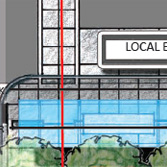
Everything in the proposal is sensitive and unobtrusive, but one should note that this project will affect the appearance of the Hopkins Center. (In fact this will be one piece in the great parade of architectural interventions in the south side of the Green of 2012 through 2020.) During the warmer months, a dense block of trees here would hide several parts of the Hop, setting up the Moore Theatre as an independent pavilion — not necessarily a bad thing, and perhaps a good stopgap until we receive a full and true Hop addition, one that brings the building right up to the street.1If the Hopkins Center were less of a suburban arts island and more of a conventional urban building (see 7 Lebanon Street), there would be no need for a warming shelter here. The business end of the Hop — everything on this facade except for the theater entrance — would come right up to the street alongside the Inn, and it would provide plenty of commercial rental space for a newsstand or a coffee shop that catered to bus travelers.
Paving
The Site Plan Concept by ORW (pdf page 4) is impressive. The most noticeable change might be the grove of trees. With a pea-gravel floor, this outdoor room screened by two ranks of trees arranged formally on axis with Wilson’s entrance (and a realigned set of Hop plaza steps) will be novel and interesting and civilized. This allee could be exquisitely beautiful in the winter with snow on the bare limbs and the tables.
The street improvements (bulbs, insular pedestrian refuge near the site of the former grassy median) are all important. The crosswalk has a note indicating that it is aligned with an axial view of Baker Library. One proposal is pretty subtle: the use of plaza paving materials (concrete pavers, say) in place of asphalt in the bus/dropoff zone. This is crucially important in reducing the perceived width of the street: Hanover is not that big, and it doesn’t need a five-lane street below the Green. Here’s hoping the paving proposal is realized. (Even if not, the plan will still remove the diagonal parking in front of the hop — good riddance.)
Maybe after this is built and enjoyed for a few years the Town will go further by raising the street level and bollarding off the plaza and the Green. The same thing should be done with the Inn’s porte-cochere and its garage ramp.2At the moment these two asphalt drives are intrusions of the street into the sidewalk, not small portions of the sidewalk opened up to cars. The paving is opposite what it should be (Street View). In both cases, the sidewalk paving should extend all the way down to the street’s edge, and the boundary line should be located there. The existing bollards and floor level/lack of curbing are appropriate, however.
Pavilion
One neat detail is a bit hidden: a little visitor’s information pavilion. In the site plan on page 4 it’s obscured by trees but is described as measuring 12 x 15 feet. On page 5 its side is shown as if seen from Wilson Hall.3In the perspective view on page 6 the pavilion is a bit hard to read. It is the dark glass box whose roof is the same height as that of the seating area in the foreground. The tall glass box near the center appears to be a possible Hop addition. The document is from July of 2011.
I imagine this pavilion helpfully blocking the wind in the winter but spending most of its time enclosing a few desultory racks of brochures for Quechee Gorge and Simon Pearce. It could replace the staffed, temporary kiosk that the Chamber of Commerce puts on the Green each summer [check]. But it could be much more: you can see its potential in the photo in the lower right part of page 3, the one showing the café tables and the menu board.
This pavilion could be a little coffee kiosk, a snack bar, or even a real bar, serving drinks out of a window.4For that matter, couldn’t the Inn breach the eastern wall of its patio and start serving people who sit under the trees here? Not quite the Tavern on the Green or even the Out of Town News in Cambridge, but certainly at least as good as a sandwich kiosk in Bryant Park.
——–
| ↑1 | If the Hopkins Center were less of a suburban arts island and more of a conventional urban building (see 7 Lebanon Street), there would be no need for a warming shelter here. The business end of the Hop — everything on this facade except for the theater entrance — would come right up to the street alongside the Inn, and it would provide plenty of commercial rental space for a newsstand or a coffee shop that catered to bus travelers. |
|---|---|
| ↑2 | At the moment these two asphalt drives are intrusions of the street into the sidewalk, not small portions of the sidewalk opened up to cars. The paving is opposite what it should be (Street View). In both cases, the sidewalk paving should extend all the way down to the street’s edge, and the boundary line should be located there. The existing bollards and floor level/lack of curbing are appropriate, however. |
| ↑3 | In the perspective view on page 6 the pavilion is a bit hard to read. It is the dark glass box whose roof is the same height as that of the seating area in the foreground. The tall glass box near the center appears to be a possible Hop addition. The document is from July of 2011. |
| ↑4 | For that matter, couldn’t the Inn breach the eastern wall of its patio and start serving people who sit under the trees here? |
Rethinking traffic around the Green
The firm of RSG writes that, in connection with the BBB master plan, it:
conducted a comprehensive evaluation of traffic circulation around the campus green, which included the development of a detailed microsimulation model to evaluate the merits of various alternatives.
It is a good bet that one of the alternatives for the Green is the return of two-way traffic. Here is the current traffic pattern:
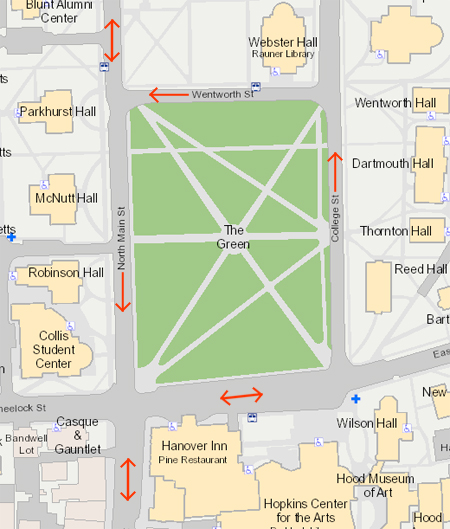
It is not clear when the streets around three sides of the Green were made one-way streets. Much of the one-waying done in the Sixties and Seventies in the interest of moving traffic through American cities is now seen as undesirable for a number of reasons. The Yale Master Plan (pdf) has several observations on pages 45 and 119:
Bicyclists tend to go the wrong way on one-way streets if they view it as the shortest path to their destination. This fact suggests the benefit of reconfiguring those streets to make cycling and walking easier.
One-way streets can be particularly hostile to those visiting Downtown, and motorists often see destinations but must recirculate through the system to reach them…. Motorists must travel further and turn more in one-way street systems than along two-way streets, and crossings are also particularly difficult for pedestrians. We recommend encouraging the City to expand its recent conversion of one-way streets to two-way traffic…. New Haven would certainly not be alone if it followed this initiative. Because of the direct impact of transportation on the accessibility and viability of urban centers, many cities are examining traffic patterns and the balance among transportation modes. To return downtown streets to a human scale and promote a more pedestrian and retail-friendly environment, recent initiatives in many places have concentrated on slowing traffic, and more and more cities have converted (or are considering converting) the one-way streets to two-way.
Here is a look at the Green with two-way traffic:
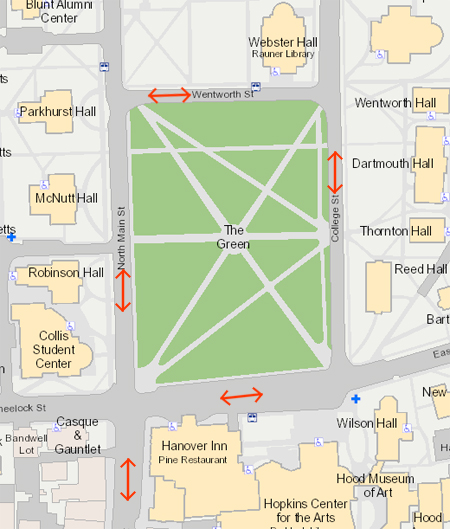
The Yale plan states on page 119:
Those traffic engineers and planners who support converting the one-way streets to two-way use readily admit that the change might selectively increase traffic congestion. However, rather than concentrating on their lost capacity to move vehicles, these professionals focus on the slower, calmer traffic and how that improves the livability and potential for growth of urban environments, business districts and neighborhoods.
Another alternative at Dartmouth might adopt another extreme, a pattern that attempts to eliminate traffic from as much of the Green as possible:
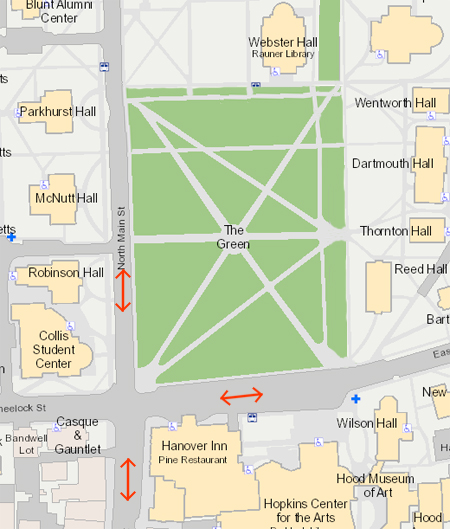
Expanding the Green in this way could make for some very pleasant spaces, particularly if the grass were carried up to SAE. Care would have to be taken to preserve some of the proportions of the streets in the paths that replaced them, an effect not shown here. Although closing College and Wentworth Streets would increase traffic on North Main and Maynard, the increase probably would not be great. Outside of term time, the Green would seem more like a dead zone (or a park, depending on your perspective) than it does now.
The list of alternatives would not be complete without a traffic circle:
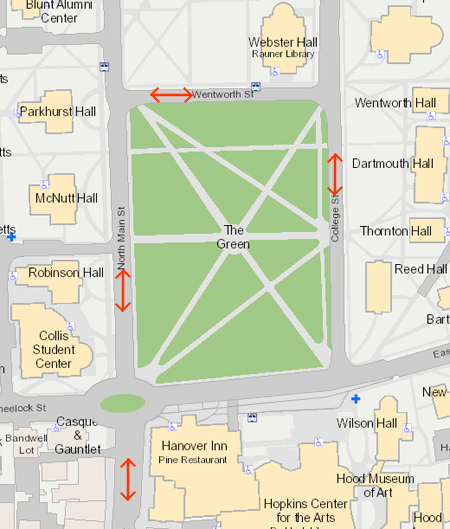
The college planners probably are not thinking of this alternative, since the redesign of the town’s main intersection seems to be more of a task for the municipal authorities. This option also removes the space-hogging diagonal parking and the turn lane from the south end of the Green.
—–
[Update 02.08.2014: RSG concludes (pdf) that “we do not feel that any of the two-way Green circulation options warrant additional investigation.” Very interesting. The report does, however, propose to narrow East Wheelock in front of the Hop in much the same way the image above does.]
The new Fullington Barn; what did Eleazar brew?
TimberHomes LLC writes:
On a warm late-October day students and staff from Dartmouth College joined the TimberHomes LLC crew to raise the Fullington Barn, a 26’x36′ timber frame structure that will be used for farm related tasks and storage. Over the course of the next two weeks students and staff will continue to work with us to “finish” the frame by installing the roof & siding material, windows & doors, and also creating an insulated room.
The Dartmouth reports on the project, and Dartmouth’s Flickr photostream has a photo. (Dartmouth is also building a 9×12 privy for two composting toilets out there, according to the Hanover Planning Board minutes of August 21, 2012, pdf.)
This barn-raising is not the first for the college. Eleazar Wheelock wrote of the period ending September 10, 1772:
I have now finished (so far as to render comfortable and decent) the building to accommodate my students, of eighty by thirty-two feet, and have done it in the plainest and cheapest manner, which furnishes sixteen comfortable rooms, besides a kitchen, hall, and store-room. I have also built a saw-mill and grist-mill, which appear to be well done, and are the property of the school, and will likely afford a pretty annual income to it. I have also built two barns, one of twenty-eight by thirty-two feet, the other of fifty-five by forty, and fifteen feet post.1Eleazar Wheelock, A Continuation of the Narrative, &c. from May 6, 1771, to September 10, 1772 (Eleazar Wheelock, 1773), 3-4.
Those are very interesting details, but it gets even better:
I have also raised, and expect to finish, within a few days, a malt-house of thirty feet square, and several other lesser buildings which were found necessary. I have cleared, and in a good measure fitted for improvement, about seventy or eighty acres of land, and seeded with English grain about twenty acres, from which I have taken at the late harvest, what was esteemed a good crop, considering the land was so lately laid open to the sun. I have cut what is judged to be equal to fourteen or fifteen tons of good hay, which I stacked, by which the expense of supporting a team and cows the ensuing winter may be considerably lessened. I have also about eighteen acres of Indian corn now on the ground, which promises a good crop. My laborers are preparing more lands for improvement; some to sow with English grain this fall, and others for pasturing[.]2Id., 4.
The Malthouse, which stood near where Wheeler Hall now stands, would have been used to prepare English grain (and corn?) for brewing in the Brewhouse:
A little more than three Years ago, there was nothing to be seen here but a horrid Wilderness, now there are eleven comfortable Dwelling-Houses (besides the large one I built for my Students, and other necessary Buildings, as Barns, Malt House, Brew-House, Shops, &c.) and some of them reputable ones, built by Tradesmen, and such as have settled in some Connection with, and have been admitted for the Benefit of this School, and the most of them near finished, and all expect to be habitable and comfortable before Winter, and all within Sixty Rods of the College[.]3Eleazar Wheelock, A Continuation of the Narrative of the Indian Charity School, &c. from Sept. 26, 1772, to Sept. 26, 1773 (Hartford, Conn.: Eleazar Wheelock, 1773), 22-23.
It is not known where the Brewhouse stood, but it would have been on or near the Green. Wheelock also described that building, or a pair of buildings, as the “brew and bake house.”4Eleazar Wheelock, Hanover, N.H., to the Honorable Trust, London, England (10 November 1773), in appendix to David McClure and Elijah Parish, eds., Memoirs of the Rev. Eleazar Wheelock (Newburyport, Mass.: Edward Little & Co.), 305-306 (“It so happens, that the store house, brew and bake house, and also the mills which I have built, stand upon my own land.”).
————————
| ↑1 | Eleazar Wheelock, A Continuation of the Narrative, &c. from May 6, 1771, to September 10, 1772 (Eleazar Wheelock, 1773), 3-4. |
|---|---|
| ↑2 | Id., 4. |
| ↑3 | Eleazar Wheelock, A Continuation of the Narrative of the Indian Charity School, &c. from Sept. 26, 1772, to Sept. 26, 1773 (Hartford, Conn.: Eleazar Wheelock, 1773), 22-23. |
| ↑4 | Eleazar Wheelock, Hanover, N.H., to the Honorable Trust, London, England (10 November 1773), in appendix to David McClure and Elijah Parish, eds., Memoirs of the Rev. Eleazar Wheelock (Newburyport, Mass.: Edward Little & Co.), 305-306 (“It so happens, that the store house, brew and bake house, and also the mills which I have built, stand upon my own land.”). |
The graphical Green; arts events
As seen at Dartmouth Now, the Year of the Arts logo initially reads as a cluster of cinema searchlight beams:
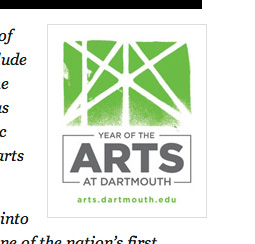
But of course it is a map of the paths on the Green, with north to the left. A larger version of the logo at the festival’s website takes on the appearance of a print, or perhaps a painting.
Coverage of the opening of the Visual Arts Center may be found in The Dartmouth and Dartmouth Now. Hood Director Taylor speaks about the Kelly sculpture and its aircraft-grade aluminum in video. The Valley News has a story on the Hop at 50, and the Year of the Arts site has a timeline of the arts on campus beginning with 1962.
Reactions to the first view of the future Inn addition
The Alumni Magazine published two letters critical of a rendering of the proposed Inn addition. (It is not clear that the rendering represents a final design.)
One writer laments the lack of a railing for putting one’s feet upon, although the rendering shows clearly that the existing railing, located within the arcade that screens the recessed porch where the rocking chairs are, will be retained.
The same letter called the design “nontraditional,” and that might be accurate. The most prominent part of the addition will be a new porte-cochere, and the rendering seems to show it as a Modernist structure. But look at the Inn itself: it features an uncharacteristic mansard roof; a lack of shutters; the omission of traditional building details such as quoining, lintels, or sills; and the absence of columns or much reference to the Classical orders. The main block of the Inn was designed by Hilton architect William B. Tabler and completed in 1967.
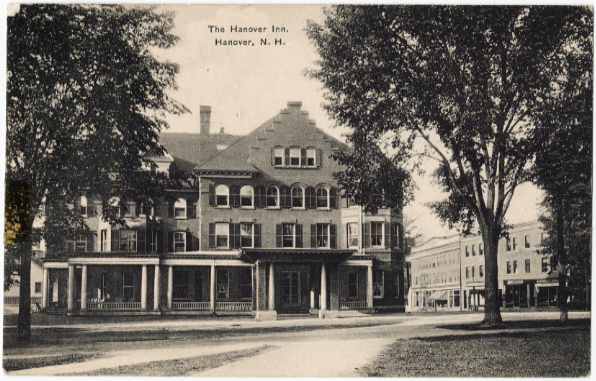
The gates of Dartmouth
Although Dartmouth seems to take some pride in having a campus without any gates, it could still benefit from the exercise of defining a campus boundary and identifying the major entrances to the academic precinct. A sketch from several years ago:
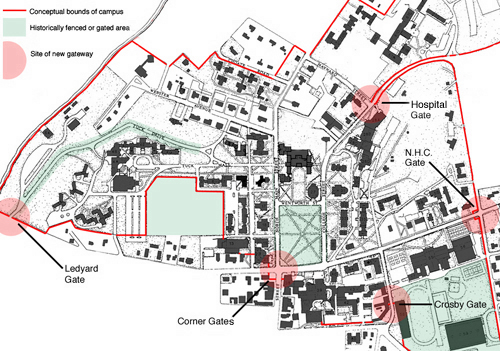
This is all fairly obvious, but it does not seem to receive much attention in writing. The greatest coherence (and the greatest support for the idea of walkability) seems to be achieved by reducing the number of gates and pulling them inward.
The only site where two gates would stand close to each other is at the southwest corner of the Green. Pulling the gates toward the center would allow them to share a single gatepost on the Green itself, but that would detract significantly from the Green and would interfere with the tree on the corner. Here, the gates should spring from the Inn and C&G (south gate) and from Collis and C&G (west gate):
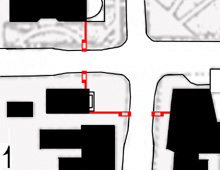
Again, this is not a proposal, and Dartmouth does not need any more* gates.
However, if this sort of project were built, and if it were differentiated from its direct ancestor, Charles McKim’s wonderful gates at Harvard, the builders couldn’t go wrong with a set massive rusticated granite piers supporting a timber truss. This would refer to the Connecticut river bridges, especially Rufus Graves’s arched truss of the late eighteenth century.
——
* Tuck Drive was built with a brick gateway at each end. The lower example survives. More recently, Scully-Fahey Field was erected with a large freestanding gateway.

Dartmouth Traditions by William Carroll Hill (1901)
Download
Download a pdf version of William Carroll Hill’s 1901 book, Dartmouth Traditions.
About the Book
William Carroll Hill (1875-1943?), of Nashua, N.H., received his Bachelor of Letters degree, a degree offered only between 1884 and 1904, in 1902. He was the historian of his class and wrote the Chronicles section of the the 1902 Class Day volume, a book that the printer gave the appearance as Dartmouth Traditions. Hill became an antiquarian, genealogist, and historian and apparently wrote a history of the New England Historic Genealogical Society.
Dartmouth Traditions was published when Hill was a junior. The book is not really about traditions and probably would be better titled Dartmouth Worthies. It is a collection of essays written by students and alumni. While the essays on Daniel Webster and other known personages are not very useful, some essays appear the contain information that is only available in this book. Examples are the report on the investigation into the history of the Lone Pine and the first-person account of the drowning death of Harriet Beecher Stowe’s son.
About this Project
The transcription of this somewhat hard-to-find book began in 2003. The book has since become available in Google Books, which somewhat defeats the purpose of the project. The Google Books version has the great advantage of reproducing the attractive typography of the original, but its computer transcription is not as accurate as that of the version presented here.
[Update 05.13.2011: The Rauner Library Blog has a post on Hill, highlighting the Stowe episode.]
[Update 12.21.2010: Link to pdf posted.]

The unidirectional kickoff
One of the distinctive features of Dartmouth-Rules Football, a local soccer of the mid-nineteenth century, was the fact that the kickoff was unidirectional. Although scoring was permitted on either the east or west side of the Green, the kickoff (called “the warn”) always went eastward from the spot where second base would be located during baseball season.
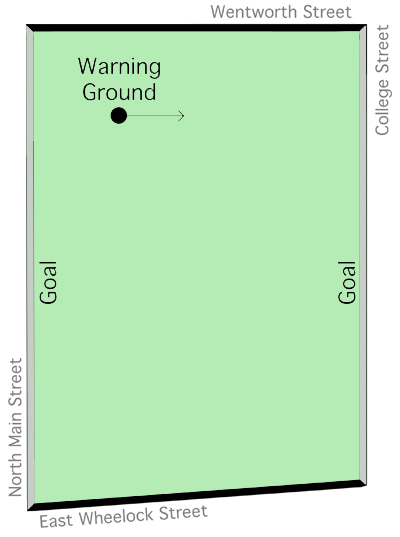
The rule might have been motivated by politics, courtesy, or efficiency. While there was nothing breakable in the college yard east of the Green, a row of professors’ houses stood on the west side.
The unidirectional kickoff was brought to mind recently with the news that the rules for the Illinois vs. Northwestern game at Wrigley Field had been changed to require all offensive plays to drive toward the west end zone. Although scoring was permitted in both end zones, when possession changed, the teams switched sides. Planners made this modification to reduce the number of plays taking in the east end zone, which is cramped by the baseball stadium’s right-field wall.
(Old Division Football basically evolved into the Football Rush, which can be seen at the 8:26 mark in this 1947 film. The arbitrary violence and utter lack of anything resembling game play suggest why the annual freshman-sophomore event later was turned into a tug-of-war and eventually was eliminated.)